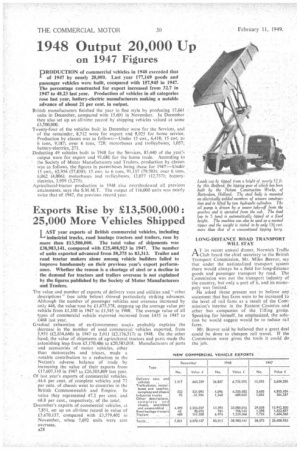Exports Rise by S13,500,000 : 25,000 More Vehicles Shipped
Page 4

If you've noticed an error in this article please click here to report it so we can fix it.
AST year exports of British commercial vehicles, including industrial trucks, road haulage tractors and trailers, rose by more than £13,500,000. The total value of shipments was £38,983,141, compared with £25,408,923 in 1947. The number of units exported advanced from 58,375 to 83,313. Trailer and road tractor makers alone among vehicle builders failed to improve handsomely on their previous year's export performance. Whether the reason is a shortage of steel or a decline in the demand for tractors and trailers overseas is not explained by the figures published by the Society of Motor Manufacturers and Traders.
The value and number of exports of delivery vans and utilities and other descriptions (see table below) showed particularly striking advances.
• Although the number of passenger vehicles sent overseas increased by only 446, the value-rose by £1,475,378, stepping up the average value per vehiele,from £1,330 in 1947 to £1,545 in 1948. The average value of all types of commercial vehicle exported increased from•E435 in 1947 to E468 last year.
Gradual exhaustion of ex-Governrnent stocks probably explains the decrease in the number of used commercial vehicles exported, from 5,951 (£2,634,640) in 1947 to 5.011 (€2,176,517) in 1948. On the other .hand, the value of shipments of agricultural tractors and parts made the astonishing leap from £5,170,486 to £20,583,018. Manufacturers of parts and accessories ' of motor vehicles, other . than motorcycles and tricars, made a notable contribution to a reduction in thz Nation's adverse balance of trade by increasing the value of their exports from £17,607,310 in 1947 to £26,503,809 last year. Of last year's exports of commercial vehicles. .44.6 per cent, of complete vehicles and 72 per cent. of chassis went to countries in the British Commonwealth and Empire. In value they represented 47.2 per cent. and 68.8 per cent., respectively, of the total. December's exports of commercial vehicles, at 7,851, set up an all-time record in value of £3,670.137, compared with £3,579,402 in November, when 7,692 units were sent overseas.
A28
LONG-DISTANCE ROAD TRANSPORT WILL STAY
AT its recent annual dinner, Norwich Traffic
Club heard the chief secretary to the British Transport Commission, Mr. Miles ,Beevor, say that under the nationalized transport system there would always be a field for long-distance goods and passenger transport by road. The Commission was not the transport industry of the country, but only a part of it, and its-monopoly was limited.
He asked those present not to believe any,. statement that bus fares were to be increased to the level of rail fares as a result of the Commission's interest in the Eastern Counties and other bus companies of the Tilling group. Speaking for himself, he emphasized, the solution he wotild suggest would be to reduce rail faxes.
Bcevor said he believed that a great deal could be done to cheapen rail travel. lithe Commission were given the tools it could do the job.


























